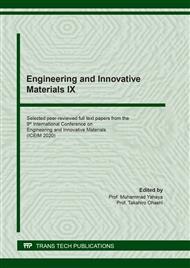[1]
H.M. Jonkers, E. Schlangen: Crack repair by concrete-immobilized bacteria, Proceedings of the first international conference on self healing materials (2007) pp.18-20.
Google Scholar
[2]
Y. Yang, E.H. Yang and V.C. Li: Autogenous healing of engineered cementitious composites at early age, Cem. Concr. Res. Vol. 41(2011) pp.176-183.
DOI: 10.1016/j.cemconres.2010.11.002
Google Scholar
[3]
H. M. Jonkers, A. Thijssen, G. Muyzer, O. Copuroglu, E. Schlangen: Application of bacteria as self-healing agent for the development of sustainable concrete, Ecological engineering Vol. 36 (2010).pp.230-235.
DOI: 10.1016/j.ecoleng.2008.12.036
Google Scholar
[4]
K. Tittelboom, N. Belie, W. Muynck, W. Verstraete: Use of Bacteria to Repair Cracks in Concrete, Cement and Concrete Research Vol. 40 (2010) p.157–66.
DOI: 10.1016/j.cemconres.2009.08.025
Google Scholar
[5]
J. Xu, W. Yao: Multiscale mechanical quantification of self-healing concrete incorporating non-ureolytic bacteria-based healing agent, Cement and Concrete Research Vol. 64 (2014) pp.1-10.
DOI: 10.1016/j.cemconres.2014.06.003
Google Scholar
[6]
Z. Prošek, P. Ryparová, P. Tesárek: Application of Bacteria as Self-Healing Agent for the Concrete and Microscopic Analysis of the Microbial Calcium Precipitation Process, Key Engineering Materials Vol. 846 (2020) pp.237-242.
DOI: 10.4028/www.scientific.net/kem.846.237
Google Scholar
[7]
C.A. Mitchell, F.G. Ferris: The Influence of Bacillus Pasteurii on the Nucleation and Growth of Calcium Carbonate, Geomicrobiology Journal Vol. 23 (2006) p.213–26.
DOI: 10.1080/01490450600724233
Google Scholar
[8]
C. Lors, J. Ducasse-Lapeyrusse, R. Gagné, D. Damidot: Microbiologically induced calcium carbonate precipitation to repair microcracks remaining after autogenous healing of mortars, Construction and Building Materials Vol. 141 (2017) pp.461-469.
DOI: 10.1016/j.conbuildmat.2017.03.026
Google Scholar
[9]
N.N.T. Huynh, N.M. Phuong, N.P.A. Toan, N.K. Son: Bacillus Subtilis HU58 Immobilized in Micropores of Diatomite for Using in Self-healing Concrete, Procedia Engineering Vol. 171 (2017) pp.598-605.
DOI: 10.1016/j.proeng.2017.01.385
Google Scholar
[10]
T. Ghosh, S. Bhaduri, C. Montemagno, A. Kumar: Sporosarcina Pasteurii Can Form Nanoscale Calcium Carbonate Crystals on Cell Surface, PLoS ONE Vol. 14 (2019).
DOI: 10.1371/journal.pone.0210339
Google Scholar
[11]
F. Hammes, N. Boon, J. Villiers, W. Verstraete, S. Douglas Siciliano: Strain-Specific Ureolytic Microbial Calcium Carbonate Precipitation, Applied and environmental microbiology Vol. 69 (2003) p.4901–4909.
DOI: 10.1128/aem.69.8.4901-4909.2003
Google Scholar
[12]
P. Nielsen, D. Fritze, F.G. Priest: Phenetic diversity of alkaliphilic Bacillus strains: proposal for nine new species, Microbiology Vol. 141 (1995) pp.1745-1761.
DOI: 10.1099/13500872-141-7-1745
Google Scholar
[13]
P. Ryparová, P. Tesárek, H. Schreiberová, Z. Prošek: The effect of temperature on bacterial self-healing processes in building materials, In: IOP Conference series: Materials Science and Engineering. Madeira: IOPscience Vol. 726 (2020).
DOI: 10.1088/1757-899x/726/1/012012
Google Scholar
[14]
Oliver W. C., Pharr G. M.: An improved technique for determining hardness and elastic modulus using load and displacement sensing indentation experiments, J. Mat. 7 (1992) 1564-1583.
DOI: 10.1557/jmr.1992.1564
Google Scholar
[15]
G. Constantinides, F-J. Ulm, K. Van Vliet: On the use of nanoindentation for cementitious materials, Materials and structures Vol. 36 (2003) pp.191-196.
DOI: 10.1007/bf02479557
Google Scholar
[16]
V. Nežerka, V. Hrbek, Z. Prošek, M. Somr, P. Tesárek, J. Fládr: Micromechanical characterization and modeling of cement pastes containing waste marble powder, Journal of Cleaner Production Vol. 195, (2018) pp.1081-1090.
DOI: 10.1016/j.jclepro.2018.05.284
Google Scholar


